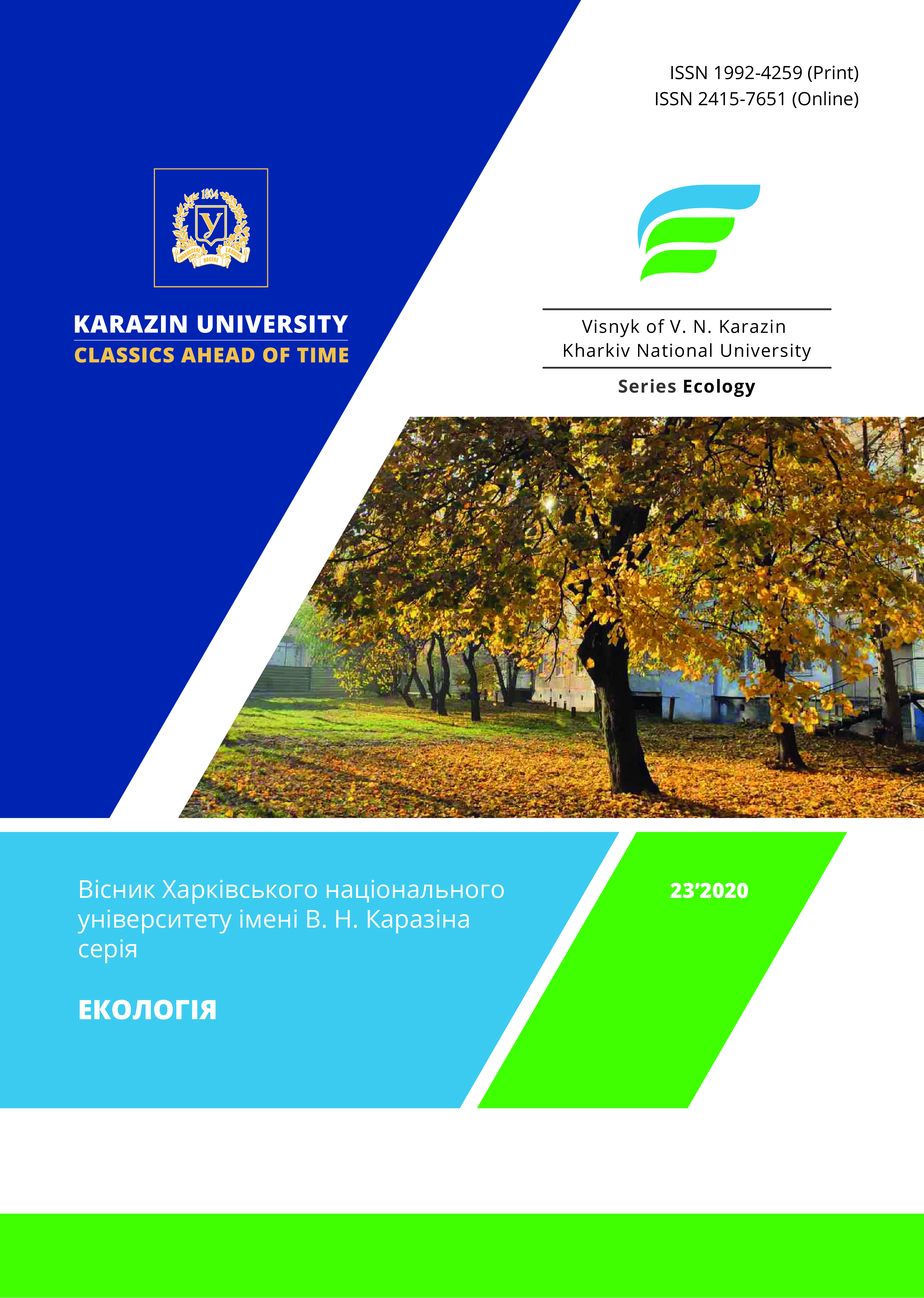Вплив концентрації аеробних бактерій на процес їх життєздатності в присутності кисню
Анотація
Мета. Дослідити життєздатність аеробних мікроорганізмів в атмосфері кисню з різним їх вихідним вмістом у водному середовищі. Порівняти вплив газу на різну концентрацію бактерій в одиниці об’єму води.
Методи. Досліджуваними мікроорганізмами слугували аеробні бактерії роду Bacillus cereus. Модельні водні середовища створені на основі дистильованої дезаерованої води при додаванні бактерій конкретного виду. Для досліджень використовувався кисень, який барботували у мікробну воду впродовж всього процесу зі швидкістю 0,2 cм3/c. Тривалість дослідження становила 2 години, впродовж якого загальна витрата газу відповідала 1,4 дм3. Число мікроорганізмів (ЧМ) до і після експериментів визначали шляхом підрахунку колоній, які виросли на чашках Петрі.
Результати. Виявлено двохстадійний процес впливу кисню на аеробні бактерії – нагромадження та зменшення їх кількості в одиниці об’єму води в ході експериментів. На першій стадії процесу спостерігалось збільшення ЧМ тривалістю 1800-3600 с з подальшим їх зменшенням (ІІ стадія). При збільшенні мікробного навантаження у воді з 102 до 104 КУО/см3 тривалість процесу нагромадження бактерій зменшилась вдвічі. Досліджено, що при низькій концентрації бактерій у воді відбувається активне розмноження бактеріальних клітин, а при високій – активне їх зменшення, що пояснюється відмиранням клітин в умовах постійної подачі кисню встановленої швидкості.
Висновки. Пояснено вплив кисню на зміну чисельності аеробних мікроорганізмів у водному середовищі. Досліджено, що дія кисню на бактерії у воді поділяє процес їх життєздатності на дві стадії: нагромадження (І стадія) та зменшення їх кількості (ІІ стадія). Показано, що тривалість процесу нагромадження бактерій в атмосфері кисню залежить від вихідної їх кількості у воді, а саме: із збільшенням вихідного ЧМ в одиниці об’єму води тривалість стадії нагромадження мікроорганізмів суттєво зменшується.
Завантаження
Посилання
Kravchenko, M. V. (2015). Physico-chemical analysis of natural drinking water from different sources of water supply. Ecological safety and nature management, 19(3), 52-60. Retrieved from http://es-journal.in.ua/issue/viewIssue/9691/4237 (In Ukrainian)
Ashbolt, N. J. (2015). Microbial contamination of drinking water and human health from community water systems. Curr. Environ. Health Rep., 2(1), 95-106. Retrieved from https://link.springer.com/article/10.1007/s40572-014-0037-5
Kong, Y., Peng, Y. & Zhang Zh. (2019). Removal of Microcystis aeruginosa by ultrasound: Inactivation mechanism and release of algal organic matter. Ultrasonics Sonochem., 56, 447-457. https://doi.org/10.1016/j.ultsonch.2019.04.017
Park, J., Son, Y. & Lee, W. H. (2019). Variation of efficiencies and limits of ultrasonication for practical algal bloom control in fields. Ultrasonics Sonochem., 55, 8-17. https://doi.org/10.1016/j.ultsonch.2019.03.007
Dirisu, G. B., Okonkwo, U. C., Okokpujie, I. P. & Fayomi, S. I. (2019). Comparative analysis of the effectiveness of reverse osmosis and ultraviolet radiation of water treatment. Journal of Ecological Engineering, 20(1), 61-75. https://doi.org/10.12911/22998993/93978
Marois-Fiset, J.-T., Carabin, A., Lavoie, A. & Dorea, C. C.(2013). Effects of temperature and ph on reduction of bacteria in a point-of-use drinking water treatment product for emergency relief. Appl Environ Microbiol., 79(6), 2107-2109. https://doi.org/10.1128/AEM.03696-12
Ivanchenko, L. V., Kozhukhar, V. YA. & Brem, V. V. (2017). Chemistry and water technology. Odessa : Ecology. (In Ukrainian)
Shin, G.-A. & Sobsey, M. D. (2008). Inactivation of norovirus by chlorine disinfection of water. Water Re-search., 42(17), 4562-4568. https://doi.org/10.1016/j.watres.2008.08.001
Mohsen, I. H., Mohsen, A. H. & Zaidan, H. K. (2019). Health effects of chlorinated water: a review article. Pac. J. Biotechnol., 16(3), 163-167. http://doi.org/10.34016/pjbt.2019.16.3.24
Wei, C., Zhang, F., Hu, Y., Feng, C. & Wu, H. (2017). Ozonation in water treatment: The generation, basic properties of ozone and its practical application. Reviews in Chemical Engineering, 33(1), 302-315. http://doi.org/10.1515/revce-2016-0008
Andronov, V., Makarov, Ye., Danchenko, Yu. & Obigenko, T. (2020). Research of the regularities of forming and chemical composition of sewage water of a dairy processing company. Scientific and technical journal «Technogenic and Ecological Safety», 7(1), 13-21. (In Ukrainian)
Myahchenko, O. P. (2010). Fundamentals of ecology. Kyiv: Center for Educational Literature. (In Ukrainian)
Koval, I. Z., Kіslenko,V. N., Starchevskii, V. L. & Shevchuk, L. I. (2012). The effect of carbon dioxide on the viability of bacteria of Bacillus and Diplococcus genera. Journal of Water Chemistry and Technology, 349(2), 112-116. Retrieved from http://jwct.org.ua/docs/t34-n2-187-194_koval.pdf
Dai, Ch., Xiong, F., He, R., Zhang, W. & Ma, Н. (2017). Effects of low-intensity ultrasound on the growth, cell membrane permeability and ethanol tolerance of Saccharomyces cerevisiae. Ultrasonics Sonochem., 36, 191-197. https://doi.org/10.1016/j.ultsonch.2016.11.035
Koval, I. & Starchevskyy, V. (2020). Gas nature effect on the destruction of various microorganisms under cavitation action. Chemistry & Chemical Technology, 14(2), 264-271. https://doi.org/10.23939/chcht14.02.264
Коval, I. (2020). Influence of oxygen and carbon dioxide on water purification from bacteria and yeast under cavitation conditions. Visnyk of V. N. Karazin Kharkiv National University series «Еcоlogy», 22, 75-82. https://doi.org/10.26565/1992-4259-2020-22-07 (In Ukrainian)
Автори, які публікуються у цьому журналі, погоджуються з наступними умовами:
- Автори залишають за собою право на авторство своєї роботи та передають журналу право першої публікації цієї роботи на умовах ліцензії Creative Commons Attribution License 4.0 International (CC BY 4.0), котра дозволяє іншим особам вільно розповсюджувати опубліковану роботу з обов'язковим посиланням на авторів оригінальної роботи та першу публікацію роботи у цьому журналі.
- Автори мають право укладати самостійні додаткові угоди щодо неексклюзивного розповсюдження роботи у тому вигляді, в якому вона була опублікована цим журналом (наприклад, розміщувати роботу в електронному сховищі установи або публікувати у складі монографії), за умови збереження посилання на першу публікацію роботи у цьому журналі.
- Політика журналу дозволяє і заохочує розміщення авторами в мережі Інтернет (наприклад, у сховищах установ або на особистих веб-сайтах) рукопису роботи, як до подання цього рукопису до редакції, так і під час його редакційного опрацювання, оскільки це сприяє виникненню продуктивної наукової дискусії та позитивно позначається на оперативності та динаміці цитування опублікованої роботи (див. The Effect of Open Access).





